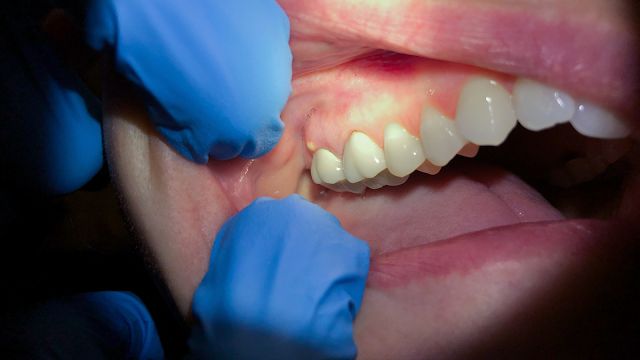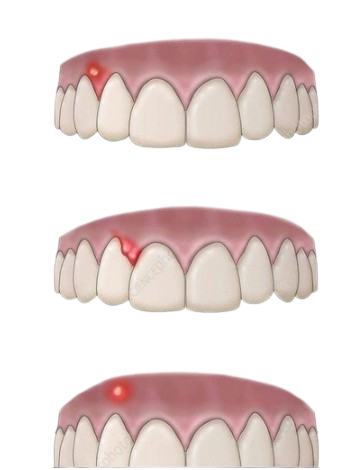Tooth Abscess : Dangers Lurking and How to Prevent It
Do you feel pain caused by a lump on your gum or tooth? Do you know what's inside the lump? Be careful, it might be a tooth abscess! This condition is more than just an inconvenience, as it can lead to serious complications if not treated properly. Let's understand what a tooth abscess is, its causes, symptoms, and how to prevent and treat it.
BODY HEALTHTOOTH ABSCESS, TOOTH ABSCESS PREVENTIONDENTAL HEALTH TIPS
11/20/20243 min read


A tooth abscess is a condition in which a pus-filled sac or lump is formed due to a bacterial infection and can appear around the tooth root or gums. Dental abscesses are generally experienced by people with poor lifestyles, especially in oral hygiene and health.
There are 3 types of tooth abscesses that you should know!
Periapical abscess - Infection at the tip of the tooth root
Periodontal abscess - Infection in the gums next to the tooth root and can spread.
Gingival abscess - Infection in the gum tissue without involving the tooth root.
Symptoms of Tooth Abscess
The main condition that people with this abscess disorder will experience is feeling throbbing pain in the teeth or gums which can come suddenly, prolonged and get worse if proper treatment is not immediately taken. There are several other symptoms that can be felt by people with tooth abscesses, namely:
Fever
Swelling of the gums and pain when chewing food
Toothache that radiates to other parts, such as the ear, jaw and neck and can conclude in head pain
Tooth decay and bad breath
Greater sensitivity to food temperature (hot/cold)
Swelling of the lymph nodes and face in the area with a tooth abscess
in severe cases, the patient can experience shortness of breath
Causes of Tooth Abscess
The exact cause of the condition of a tooth abscess is due to the development of bacteria in the mouth that manages to enter through holes or cracks in the patient's teeth. This causes inflammation and swelling at the root end of the tooth or gum. This bacterial infection can arise from things that are considered trivial, such as;
Ignoring cavities, especially cavities due to frequent consumption of foods and drinks with a high sugar content. this condition if left untreated can be the main route for bacteria to enter the inside of the tooth (pulp). When bacteria have reached the pulp, they can cause an infection that leads to a buildup of pus or what is known as an abscess.
Infrequent brushing, infrequent brushing or not cleaning between the teeth properly can increase the risk of plaque and bacteria buildup that leads to infection and abscess formation.
Infection after tooth extraction, after removing a tooth, if the extracted area is not properly treated, there will be bacterial contamination that can form an abscess.
Having an immune system that is not good enough, someone with a poor immune system, such as diabetics, HIV / AIDS, patients with kidney failure, cancer will be more susceptible to infections, including abscesses in the teeth.
When to See a Dentist?
Immediately see a doctor to get fast and proper treatment if you experience one or more of the symptoms above. Because infection from a tooth abscess can spread to other areas, such as the jaw, sinuses, and even to the bloodstream which can result in sepsis. Early treatment will prevent serious complications and speed up recovery, don't take anything your body is feeling lightly!
Effective Treatment for Patients with Tooth Abscess
To treat bacterial infection and pus in the teeth or gums, the dentist will perform the following actions:
Drainage of the abscess, the doctor will remove the pus to reduce infection and pain and relieve swelling.
Antibiotics, antibiotics will be given when it is known that the infection has spread and are not needed when abscess drainage has been done.
Root Canal Treatment, this procedure is done to remove the infection by hollowing out the tooth to the bottom to remove the soft tissue or pulp that is the center of the infection and clean it. After the removal, the hollowed-out tooth will be fitted with a dental crown or denture casing.
Tooth Extraction, if the tooth cannot be saved, the doctor will perform this procedure to remove the infection.
Prevention of Tooth Abscess
The simplest and easiest way to prevent a tooth abscess is to prevent its damage. Some ways that can keep the tooth from decay and other bad conditions are as follows:
Brush your teeth at least twice a day with toothpaste containing fluoride
Replace toothbrushes regularly every 3 months or when the bristles on the brush are no longer suitable for use
Clean between the teeth every day with dental floss or floss
Do not rinse your mouth with special medicine after brushing your teeth, it can eliminate the benefits of the content of the toothpaste used
Reduce the consumption of foods and beverages that are high in sugar and flour, especially during meals and before bedtime
Regular dental check-ups with the dentist every 6-12 months.
A tooth abscess is a serious condition that should not be ignored. Prompt and appropriate treatment is essential to prevent more dangerous complications. Maintain good oral hygiene and watch for early signs of infection. Start taking your body's pain signals as a warning not to underestimate something that could be a danger to your health. Take care of your diet and oral hygiene for long-term comfort!
tooth abscess - a pus-filled lump on the gum


Differences of tooth abscess types
Periapical abscess
Periodontal abscess
Gingival abscess
